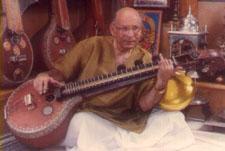Tribute
DR S BALACHANDER - A MULTIFACETED GENIUS
Born at Chennai on January 18, 1927, Balachander was one of India's foremost musicians and a leading exponent of the Vina.
Even at the age of five, Balachander showed great interest in classical music and a greater desire to play on more than one musical instrument. A concert artiste by the age of six, he accompanied his elder brother, vocalist S. Rajam on the Khanjira.
He went on to master other instruments like tabla, harmonium, bulbultara, mridangam, tar-shenai, dilruba, tabla-tarang and sitar. Before he was in his teens, he was a full-fledged solo sitarist and performed extensively.

The
Balachander-bani
However, it was after he took to the Vina that Balachander's musical genius found full-
expression. Striding the musical world like a colossus, he was responsible for creating a
whole new style with his at once chaste and modern approach. Though Balachander did not
have any master or tutor to teach him or even guide him through his initial stages, he
never felt it a handicap. It gave him the opportunity to practice on his own and strive
for perfection.
Unaided and untutored, Balachander evolved what is popularly known as the
Balachander-bani, the essence of which was to adhere to the spirit of vocal music. This he
achieved by pulling (deflecting) the strings over the frets to ensure optimum continuity
with a single pluck of the string. An uncompromising traditionalist and classicist,
Balachander firmly believed that musical values shouldn't be diluted or corrupted in the
name of innovation or modernisation.
With his singular dedication and hard-work, Balachander gave the ancient instrument a new
lease of life and secured it a place as a solo concert instrument, while before him, it
was treated mainly as an instrument for chamber concerts.
An authority on the theoretical aspects of music, Balachander's lecture-demonstrations in
India and abroad were marked with clarity and simplicity. His monumental work of recording
the 72-melakartas in a collection of 12 LP records is one of his most significant
contributions to musical posterity.
Not surprisingly, Balachander was the recipient of various honours and awards in India and
abroad. It includes the Padma Bhushan (the second highest civilian award), awarded by the
President of India. Besides, two foreign Universities awarded him honorary doctorates.
Balachander traveled extensively all over the world.
The other side
Balachander and controversies walked hand in hand. Bold and outspoken, he launched
campaigns, unmindful of personal popularity or consequences, to uphold his principles. In
the last years of his life, Balachander waged a relentless battle to expose what he called
the "Swati Tirunal hoax".
Balachander was certainly a master of several trades, having been a Chess prodigy. His
success also extended to films, 6 of which he directed. He was famous for his
suspense-thrillers and came to be known as the Alfred Hitchcock of South India. He
composed the music for his films and even acted in over 12 movies. In an age where Indian
films were replete with song and dance, his Tamil suspense thriller "Anda Naal"
was a trend-setter, which had a complex and highly original screenplay and went on to win
the President's Award for Best Feature Film.
A performing concert artiste till the very end, Balachander passed away on Friday the 13th
April 1990 at Bhilai in Madhya Pradesh where he had gone for concerts and
lecture-demonstrations.